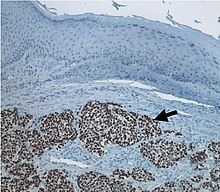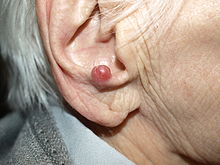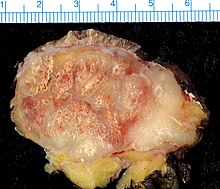Merkel cell carcinoma
| Classification according to ICD-10 | |
|---|---|
| C44 | Other malignant neoplasms of the skin |
| ICD-10 online (WHO version 2019) | |

The Merkel cell carcinoma or cutaneous neuroendocrine carcinoma of the skin is a very rare malignant skin tumor. The name is based on ultrastructural similarities with the Merkel cells of the epidermis, although it is no longer assumed today that the Merkel cells represent the starting cells of the neoplastic transformation.
The incidence is 0.1 to 0.3 new cases per 100,000 population and year. The reddish-spherical-looking tumors that typically occur in old age tend to grow - but not only - on areas of skin on the face and extremities that are chronically exposed to light. Ulceration of the tumor is rare. A connection between tumor development and UV exposure is suspected. In the northern hemisphere, the majority of diseases are associated with the Merkel cell polyomavirus , which was discovered in 2008 .
diagnosis
The diagnosis is made by taking a sample and examining the tissue. In addition, an immunohistochemical examination is always necessary in order to distinguish it from other similar-looking tumors. Since Merkel cell carcinomas metastasize , a diagnosis of the spread of the lymphatic system is also carried out, usually in the form of a sentinel lymph node biopsy .
According to the AJCC classification from 2017, the disease is divided into different stages depending on its clinical characteristics:
- Stage I (patients with primary tumor size ≤2 cm)
- Stage II (patients with primary tumor size> 2 cm)
- Stage III (patients with positive lymph node involvement)
- Stage IV (patients with distant metastases)
The majority of diseases (35–52%) are diagnosed in stage I, followed by stage III (23–35%), stage II (15–26%) and finally stage IV (5–12%). Metastatic Merkel cell carcinoma (stage IV) is usually observed within the first three years of diagnosis and is associated with a poor prognosis. The most common areas affected by metastasis are the draining lymph nodes, distant skin, lungs, central nervous system, bones, and liver.
The recurrence rate for Merkel cell carcinoma is high. About half of patients with positive sentinel lymph nodes will have a relapse within three years.
therapy
The tumors are surgically removed with a safe margin, and a sentinel lymph node biopsy is recommended. In addition to the operation, the tumor bed and the locoregional lymph drainage station should be irradiated.
System therapies are generally only used as palliative therapy for patients with metastatic Merkel cell carcinoma (stage IV). In addition to monotherapy with anthracyclines or taxanes , combination therapies with platinum derivatives and etoposide are also used. There are no comparative studies on the effectiveness of the various chemotherapy regimens.
In principle, metastatic Merkel cell carcinoma is a chemosensitive tumor with a high response rate in the first line of drug treatment, but the response to therapy is short-lived. In the second line of therapy, the response rates are already lower. There is therefore a great need for clinical studies investigating new substances that lead to sustained therapeutic responses in metastatic Merkel cell carcinoma.
PD-1 / PD-L1 inhibitors, so-called checkpoint inhibitors, are currently being investigated in this entity. At the end of September 2017, the checkpoint inhibitor avelumab was approved for the treatment of Merkel cell carcinoma in the EU.
The prognosis depends very much on the stage of the disease and is worse with tumors in the head and neck region or on the trunk. Men and patients with immunosuppression also have poorer prospects.
Risk factors
Merkel cell carcinoma is more common in patients with immunosuppression, e.g. B. haematological diseases, organ transplants or AIDS and shows a more aggressive course in these patients.
Other risk factors are age, fair skin, previous malignant tumors and chronic UV exposure.
Individual evidence
- ↑ CM Sauer, AM Haugg, E. Chteinberg, D. Rennspiess, V. Winnepenninckx: Reviewing the current evidence supporting early B-cells as the cellular origin of Merkel cell carcinoma . In: Critical Reviews in Oncology / Hematology . tape 116 , August 2017, ISSN 1879-0461 , p. 99-105 , doi : 10.1016 / j.critrevonc.2017.05.009 .
- ^ JC Becker: Merkel cell carcinoma . In: Annals of Oncology . tape 21 , suppl_7, October 1, 2010, ISSN 0923-7534 , p. vii81 – vii85 , doi : 10.1093 / annonc / mdq366 ( oup.com [accessed September 19, 2017]).
- ↑ C. Garbe: Merkel cell carcinoma guideline of the German Cancer Society. Tübingen 2005.
- ↑ F. Toberer, S. Werchau: Merkel cell carcinoma - a highly aggressive tumor with a possible viral origin. In: The surgeon. 2011/8. doi: 10.1007 / s00104-010-2066-4
- ↑ Celeste Lebbe, Jürgen C. Becker, Jean-Jacques Grob, Josep Malvehy, Veronique del Marmol: Diagnosis and treatment of Merkel Cell Carcinoma. European consensus-based interdisciplinary guideline . In: European Journal of Cancer . tape 51 , no. 16 , p. 2396–2403 , doi : 10.1016 / j.ejca.2015.06.131 ( elsevier.com [accessed September 19, 2017]).
- ↑ Stephen B. Edge, Carolyn C. Compton: The American Joint Committee on Cancer: the 7th Edition of the AJCC Cancer Staging Manual and the Future of TNM . In: Annals of Surgical Oncology . tape 17 , no. 6 , June 1, 2010, ISSN 1068-9265 , p. 1471–1474 , doi : 10.1245 / s10434-010-0985-4 ( springer.com [accessed September 19, 2017]).
- ↑ Peter J. Allen, Wilbur B. Bowne, David P. Jaques, Murray F. Brennan, Klaus Busam: Merkel Cell Carcinoma: Prognosis and Treatment of Patients From a Single Institution . In: Journal of Clinical Oncology . tape 23 , no. 10 , April 1, 2005, ISSN 0732-183X , p. 2300–2309 , doi : 10.1200 / jco.2005.02.329 ( ascopubs.org [accessed September 19, 2017]).
- ↑ Jayme B. Stokes, Katherine S. Graw, Lynn T. Dengel, Brian R. Swenson, Todd W. Bauer: Patients With Merkel Cell Carcinoma Tumors ≤ 1.0 cm in Diameter Are Unlikely to Harbor Regional Lymph Node Metastasis . In: Journal of Clinical Oncology . tape 27 , no. 23 , August 10, 2009, ISSN 0732-183X , p. 3772–3777 , doi : 10.1200 / jco.2008.20.8272 ( ascopubs.org [accessed September 19, 2017]).
- ↑ Aleodor A. Andea, Daniel G. Coit, Bijal Amin, Klaus J. Busam: Merkel cell carcinoma . In: Cancer . tape 113 , no. 9 , November 1, 2008, ISSN 1097-0142 , p. 2549-2558 , doi : 10.1002 / cncr.23874 ( wiley.com [accessed September 19, 2017]).
- ↑ Aleodor A. Andea, Raj Patel, Selvarangan Ponnazhagan, Sanjay Kumar, Patricia DeVilliers: Merkel cell carcinoma: correlation of KIT expression with survival and evaluation of KIT gene mutational status . In: Human Pathology . tape 41 , no. 10 , p. 1405–1412 , doi : 10.1016 / j.humpath.2010.02.010 ( elsevier.com [accessed September 19, 2017]).
- ↑ Juan A. Santamaria-Barria, Genevieve M. Boland, Beow Y. Yeap, Valentina Nardi, Dora Dias-Santagata: Merkel Cell Carcinoma: 30-Year Experience from a Single Institution . In: Annals of Surgical Oncology . tape 20 , no. 4 , April 1, 2013, ISSN 1068-9265 , p. 1365–1373 , doi : 10.1245 / s10434-012-2779-3 ( springer.com [accessed September 19, 2017]).
- ↑ Timothy L. Fitzgerald, Samuel Dennis, Swapnil D. Kachare, Nasreen A. Vohra, Jan H. Wong: Dramatic Increase in the Incidence and Mortality from Merkel Cell Carcinoma in the United States . In: The American Surgeon . tape 81 , no. 8 , August 2015, ISSN 1555-9823 , p. 802-806 , PMID 26215243 .
- ↑ Dirk Schadendorf, Céleste Lebbé, Axel zur Hausen, Marie-Françoise Avril, Subramanian Hariharan: Merkel cell carcinoma: Epidemiology, prognosis, therapy and unmet medical needs . In: European Journal of Cancer . tape 71 , p. 53-69 , doi : 10.1016 / j.ejca.2016.10.022 ( elsevier.com [accessed September 19, 2017]).
- ↑ H. Medina-Franco, MM Urist, J. Fiveash, MJ Heslin, KI Bland: Multimodality treatment of Merkel cell carcinoma: case series and literature review of 1024 cases . In: Annals of Surgical Oncology . tape 8 , no. 3 , April 2001, ISSN 1068-9265 , p. 204-208 , PMID 11314935 .
- ↑ E. Voog, P. Biron, JP Martin, JY Blay: Chemotherapy for patients with locally advanced or metastatic Merkel cell carcinoma . In: Cancer . tape 85 , no. 12 , June 15, 1999, ISSN 0008-543X , p. 2589-2595 , PMID 10375107 .
- ↑ Sheela G. Gupta, Linda C. Wang, Pablo F. Peñas, Martina Gellenthin, Stephanie J. Lee: Sentinel Lymph Node Biopsy for Evaluation and Treatment of Patients With Merkel Cell Carcinoma: The Dana-Farber Experience and Meta-analysis of the Literature . In: Archives of Dermatology . tape 142 , no. 6 , June 1, 2006, ISSN 0003-987X , p. 685-690 , doi : 10.1001 / archderm.142.6.685 ( jamanetwork.com [accessed September 19, 2017]).
- ↑ Systematic literature review of efficacy, safety and tolerability outcomes of chemotherapy regimens in patients with metastatic Merkel cell carcinoma . In: Future Oncology . tape 13 , no. 14 , March 28, 2017, ISSN 1479-6694 , p. 1263–1279 , doi : 10.2217 / fon-2017-0072 ( futuremedicine.com [accessed September 19, 2017]).
- ↑ NCCN: Merkel Cell Carcinoma guidelines Version 1. (PDF) Retrieved on September 19, 2017 .
- ↑ Jann Arends: Tumors of the skin: Basics, diagnostics and therapy in dermatological oncology; 167 tables . Georg Thieme Verlag, 2010, ISBN 978-3-13-142171-5 , p. 610.
- ↑ Patrick Terheyden, Jürgen C. Becker: New developments in the biology and the treatment of metastatic Merkel cell carcinoma . In: Current Opinion in Oncology . tape 29 , no. 3 , May 1, 2017, ISSN 1040-8746 , p. 221-226 , doi : 10.1097 / cco.0000000000000363 ( ovid.com [accessed September 19, 2017]).
- ↑ EU approval for Bavencio. In: apotheke-adhoc.de. September 21, 2017. Retrieved September 27, 2017 .
- ↑ S2k - Brief guideline - Merkel cell carcinoma ( Memento of the original from February 18, 2017 in the Internet Archive ) Info: The archive link was inserted automatically and has not yet been checked. Please check the original and archive link according to the instructions and then remove this notice.
- ↑ Dirk Schadendorf, Céleste Lebbé, Axel zur Hausen, Marie-Françoise Avril, Subramanian Hariharan: Merkel cell carcinoma: Epidemiology, prognosis, therapy and unmet medical needs . In: European Journal of Cancer . tape 71 , p. 53-69 , doi : 10.1016 / j.ejca.2016.10.022 ( elsevier.com [accessed September 19, 2017]).
Web links
- Merkel cell carcinoma on the website "The Online Encyclopedia of Dermatology, Venereology, Allergology and Environmental Medicine" by Peter Altmeyer , University Dermatology Clinic Bochum
- merkelzell.de the website is aimed at the layperson and describes risk factors, diagnoses, causes and prevention

